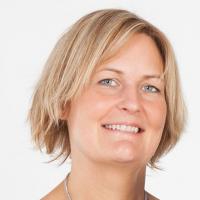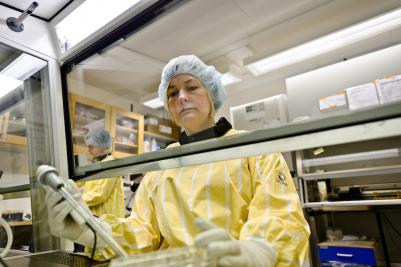Interview with Malin Parmar: Cell therapy for Parkinson’s disease

Malin Parmar heads a research group focused on developmental and regenerative neurobiology at Lund University in Sweden. The ultimate goal of her research is to develop cell therapy for Parkinson’s disease.
At this year’s Hydra summer school I spoke to Malin about how she got started in stem cell research, what she’s working on at the moment, and her view of the prospects for treating Parkinson’s disease with stem cells.
How did you get into stem cell research? Was there a moment or did it happen over time?
I’ve always had an interest in science and in understanding how things work. When I was 10 I saved my allowance and went out and bought myself a microscope. I was driven by curiosity, but I didn’t have any particular long-term aspirations like curing a specific type of disease.
I did my undergraduate and masters studies in Canada, and a PhD in developmental neuroscience in Sweden - I wasn’t working with stem cells at all. I worked on the development of the forebrain. At the very end of my PhD it became possible to culture neural stem cells and expand them in vitro, so I did a study on these cultures and found the results fascinating. This opened up so many new questions.
From there I did my postdoc with Anders Björklund, where we worked on differentiating neurospheres into dopamine neurons – the kind of neurons that are lost in Parkinson’s disease. This proved difficult so we turned to embryonic stem cells. I moved to Edinburgh for a post-doc where I learnt to differentiate mouse and human embryonic stem cells into dopamine neurons.
It was following my time in Edinburgh that I set up my own lab in Lund, trying to use embryonic stem cells for human cell therapy. We soon moved on different approaches for cell reprogramming and managed to directly reprogram human skin cells into dopamine neurons, which has generated publications, grants and new opportunities.
Why Parkinson’s?
Parkinson’s disease is a good candidate for cell therapy as one cell type is affected, dopamine neurons, and degeneration is relatively local. Losing dopamine neurons leads to motor deficits such as rigidity, slower movements and also problems in cognition. Some current treatments do help alleviate symptoms, but do not halt disease progression and there are adverse affects. So there has been increasing interest in, and need for, cell therapies to replace lost dopamine neurons.
What are you working on at the moment?
 I’m currently working on several interesting projects. I’m part of one European study called TRANSEURO, which is now at the stage of transplanting fetal cells into patients with Parkinson’s disease as part of a new clinical trial. It’s quite exciting to be part of that! I’m coordinating the tissue team in Lund which is one of the two transplantation sites.
I’m currently working on several interesting projects. I’m part of one European study called TRANSEURO, which is now at the stage of transplanting fetal cells into patients with Parkinson’s disease as part of a new clinical trial. It’s quite exciting to be part of that! I’m coordinating the tissue team in Lund which is one of the two transplantation sites.
I also work in a European network known as NeuroStemcellRepair, a European stem cell consortium looking at neural cell replacement, reprogramming and functional brain repair, also with a focus on Parkinson’s.
Then there’s GForce-PD, a global task force for developing stem cell therapy for Parkinson’s. This involves research teams in the US, Europe and Japan working together to standardize research and clinical protocols for Parkinson's disease.
How do those collaborations come about?
I focus on developing new, cell based therapies for Parkinson’s disease, a task which needs neurologists, neurosurgeons, ethicists, stem cell biologists, experts on in vivo pre-clinical models; its not a one person job, you need a team. I’m a networker and I love working in a team. The best collaborations that I’ve been part of come from being out and about, from conferences and summer schools like this one, when you meet other scientists. And EU networks like EuroStemCell, NeuroStemcell Repair and others really facilitate a collaborative way of working.
The work on fetal transplantation is interesting, is this a field that’s just reappeared?
Since the early fetal-cell studies in the 1980s and 90s there hadn’t been much advance, and also some dissapointments in the field. The clinical trials had produced varying results that were hard to interpret. That’s why at TRANSEURO we’re working to address the previous issues that occurred in order to perform an improved clinical trial.
I coordinate the tissue prep team in Lund. This has really been an eye opener in terms of regulations and working towards GMP standards; your science will not go anywhere if you do not comply with the set regulations. Hence, you must find a way to make your procedures comply with the guidelines. The initial cell transplants were carried out in the late eighties and early nineties but a lot has changed since then. The TransEuro project itself was even delayed by a year and a half due to difficulties in regulatory compliance and the interpretation of European guidelines. I’ve learnt a lot from this and now understand the complexity. I’ll be in a better position for when we take embryonic stem cells to the clinic.
What are the three main questions to be answered in stem cell therapy for Parkinson’s disease?
With pluripotent stem cells we know that we can create functional dopamine neurons. Here we need to solve the safety issues associated with pluripotent stem cells and how to upscale these neurons – produce them in large quantities.
Secondly, as a field we need to work more closely with regulatory agencies to make the path towards to the clinic clearer and hopefully quicker.
Finally, the reprogrammed cells are very interesting but a much newer field than work with ES cells. In this area we need to find a way to create functional cells without integrating viruses into the host genome that survive and function in vivo.
What’s your aspiration for your field?
Well I’m 40 … in my lifetime I’d like to see stem cells in regular use in the clinic.
Some final thoughts…what do you think are the main qualities to make it in science?
Well I don’t think it’s down to one thing, what’s important is to do good science that will take the field forward. Also it’s important to be part of a strong scientific network.
And what would be your advice to young scientists?
Be driven by the science and your own curiosity and enthusiasm, not by the chance to publish in high impact journals or obtain prestigious grants.
Projects
- TRANSEURO
- GForce-PD - A Global Effort to Bring Cell Based Therapies to PD Patients
- Parmar group webpage: Developmental and Regenerative Neurobiology
News articles
Acknowledgements
Thanks to Vanessa De Mello for her help transcribing and writing up this interview.
Images by Kennet Rouna, courtesy of Malin Parmar
Last updated: